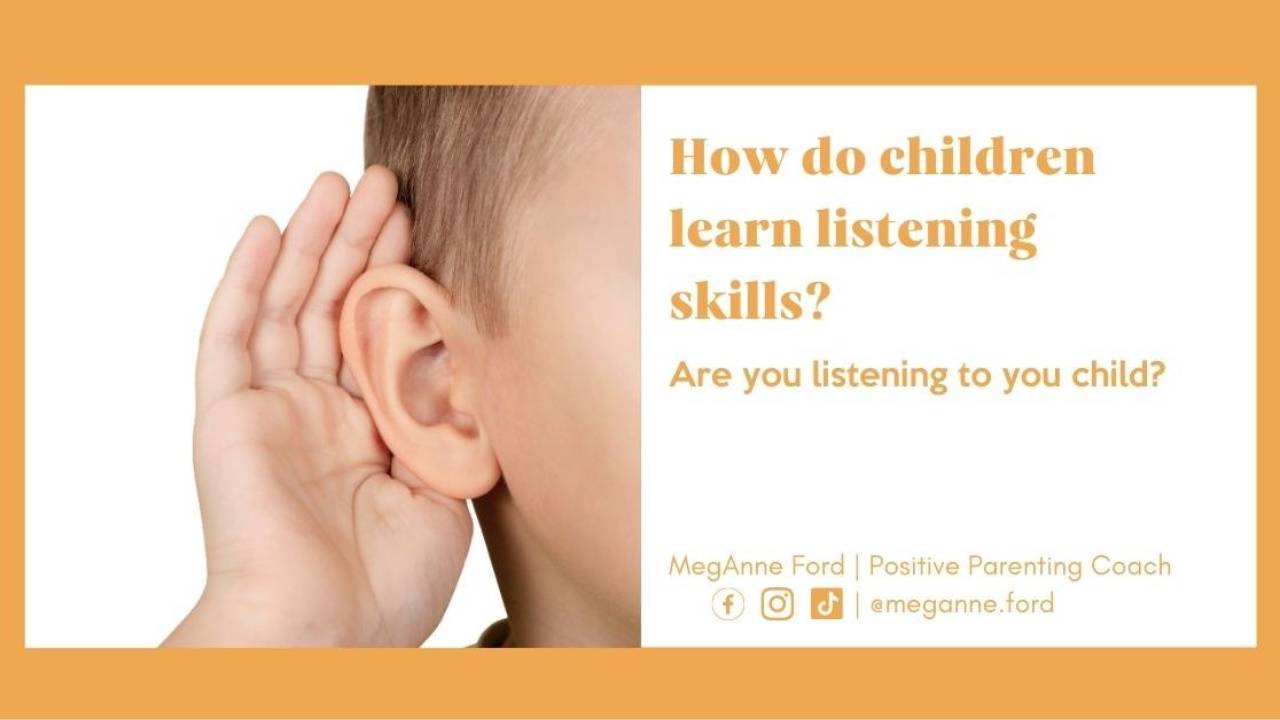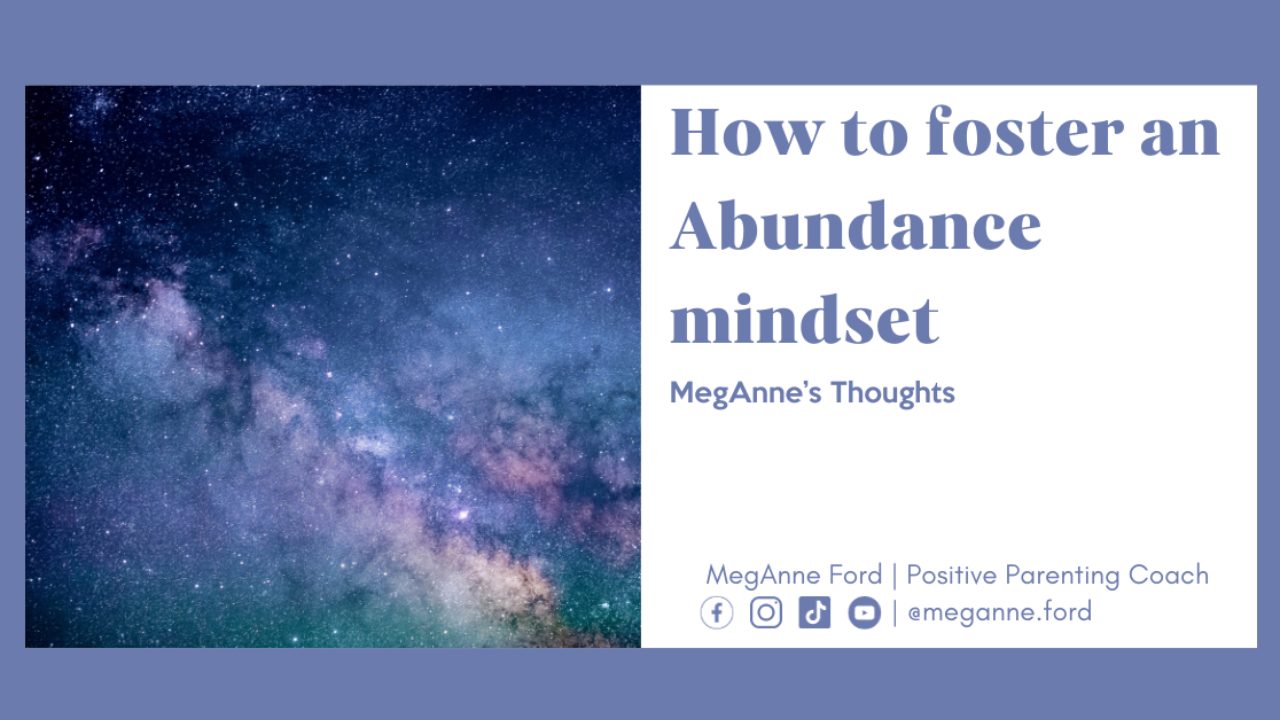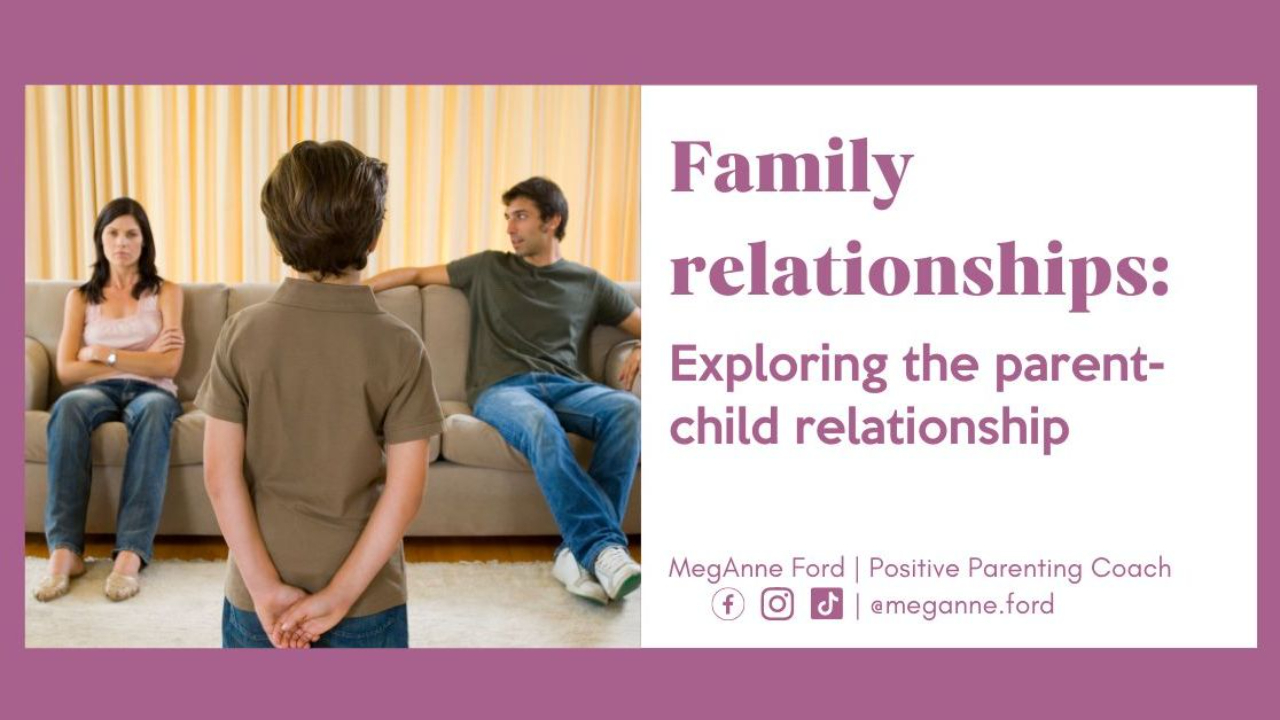
Parent Class Near Me: Parent-Child Relationship
Jan 12, 2023My passion is strengthening family relationships. I help parents learn effective methods and strategies with parenting classes. I am a former early childhood educator turned parent coach.
Be on the lookout for getting triggered by this content. What we are exploring may invite big feelings. If that is the case, listen to them and take care of yourself and those big feelings as you read ahead.
When did your parent-child relationship start?
I would like you to think about the moment you discovered that you would be a parent. Be it a pregnancy test, the moment you decided to adopt a child or any other way, you began the process of bringing a child into your life. That was the beginning of your side of the parent-child relationship.
Your relationship with your child started when you began preparing to become a parent. Picking out the nursery's colors, choosing their name, and all the things that go into preparing to become a parent. Now, let's consider when the relationship began for your child. I think we can agree that you had a head start and the space to prepare on your side of the relationship. The family relationship starts uneven and creates an uneven power dynamic, which makes the family relationship asymmetrical. To have a good relationship between parent and child, as a parent, you must de-center your experience as a parent.
That statement might trigger feelings of uncertainty. What do I mean, de-center? I invite you to stay gentle with yourself as we seek ways to de-center yourself from that asymmetrical parent-child family relationship. Parents hold so much power within these relations, just as Uncle Ben tells Peter Parker in Spider-man, “with great power comes great responsibility.” Let’s consider that responsibility and lean into it while we begin to see things from a new perspective.
When a relationship is asymmetrical, the person who holds more power must do the work first. That is the good news. As parents, guardians, caregivers, and adults in a child’s life, we have control over what sometimes feels like an uncontrollable situation.
Decoding the family relationship
Let’s start by stating the definition of the word relationship:
The way in which two or more concepts, objects, or people are connected
It's the state of being connected that forms the relationship. Some relationships feel safe, some feel unsafe, some are professional, and some are romantic. The more intimate the relationship describes how two or more people are connected.
Symmetrical Relationship
The first we will describe is symmetrical, which is made up of exactly similar parts facing each other or around an axis. A symmetrical relationship is a relationship that shows symmetry. It's the same on both sides. An example of a symmetrical relationship is a friend, co-worker, sibling, partner, or spouse. The dyad is even, and the relationship is even.
Asymmetrical Relationship
Asymmetrical means having parts that fail to correspond to one another in shape, size, or arrangement. It simply means that it lacks symmetry. There's an imbalance when we think about these relationships.
An example would be a doctor and patient relationship. There’s an even relationship between power, knowledge, and education. The doctor holds more over the patient. The patient is at the will to trust the doctor.
Another example of an asymmetrical relationship is between a boss and an employee. The boss holds more power and has more responsibility. A traditional boss can transcend and become a leader who supports the employees, shares that power, and invites the employees to feel empowered. The last example is the parent and child family relationship.
Simply put, an asymmetrical relationship means that the dyad is uneven.
Complementary Relationship.
Complementary means combining two pieces in a way that is to enhance or emphasizes the qualities of each other. It becomes a good match. An asymmetrical relationship can become complementary. It means that the dyad is uneven, but it matches well.
An example of this could be a well-matched doctor-patient, employer-employee, or child-parent. You can picture puzzle pieces coming to fit together.
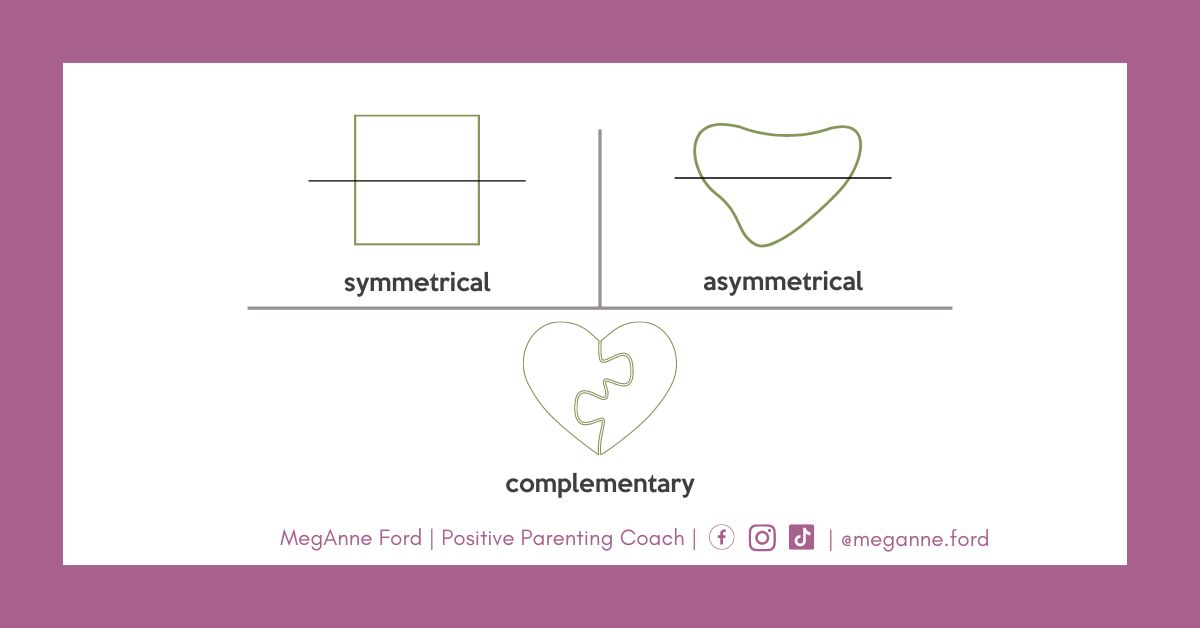
Let’s start creating an attachment childhood for your kids.
As we have stated, the parent-child relationship is asymmetrical. Now, how can we begin to create a complementary family relationship? The act of becoming complementary is to work together to build a strong and secure relationship together.
We can learn that the parent's role is to fill the child's needs. The adult then models how to fill their own needs. The child in this relationship is not responsible for fulfilling the needs of the adult. We discuss the relationships we’re building in our lives and the idea of becoming a gardener parent in the blog, Where can I find the parenting manual? The gardener is tending and caring for and becoming attuned, becoming curious. Once attuned, we can assess the child's needs like a gardener does to their plants. The carpenter's parent has a plan, and anything outside that plan is wrong. They do everything in their power to get you back to that plan.
Watch out for this blind spot
Parentification:
“very simply put, emotional parentification is a dynamic between a child and their caregivers it occurs when a child starts to feel responsible for taking care of their parents emotionally while growing up” - Hala Samsi
Some of us can recognize this as we look back at our childhood. We started to wear different masks to appease the adults around us. We can look back at the various power dynamics in relationships like teacher-student, coach-player, and parent-child. We can become aware when the adult asks the child to submit their needs so that the adult feels comfortable.
Parentification can look like children constantly trying to accommodate how their parents feel. A child can sense the footsteps in the house and the sounds of the car pulling into the driveway and think, “whoop, I need to do something so that my parent feels comfortable.”
The child becoming a source of emotional support for the caregiver is another example of parentification. The child now feels responsible and maybe even flooded in high conflict, stressful or traumatic situations. The child starts to soothe and regulate their parent's emotions and become accountable for their feelings. Essentially, the parents begin to overshare their emotional pain and age-inappropriate problems with the children and lean on them for support or expect them to help them with problem-solving. The children are placed in situations where they feel more like the parent.
“Wait, I’m I supposed to be a robot?”
I think emotional honesty and emotional validation are essential. I think inviting children into the process of family contributions is vital. We need to make sure that it is age-appropriate. Those expectations and those sharings must match the child’s development.
For example, grocery shopping for a three-year-old would be overwhelming, but including them in the grocery shopping process could be a learning opportunity. The idea is to involve the child with support and not totally outsource. As the child grows, their skills grow, and how they can be involved changes and matures. This process of staying in age-appropriate zones aligns with nurturing a secure childhood attachment.
Family relationship: Discussing the childhood attachment
There is value in knowing that a parent-child relationship is an asymmetrical relationship and owning our power in it. There are four qualities that the attachment theory considers; how safe the child feels, how seen the child is, how soothed the child is, and how secure the child feels.
It is important to note that this is from the child’s perspective. We don't get to say if someone feels safe with us. They get to say that they feel safe with us.
We talk about this concept in this blog, Am I a bad parent? How to start connecting to your child, leaning into impact over intentions. The child is often not safe, seen, soothed, and secure solely from the parent's intentions.
We're starting to see it from the child's perspective and asking questions like; How can I help my child feel safe? How can I help my child feel seen? How can I help my child feel soothed? How can I help my child feel secure? What is required of me to do first?
Feeling Safe
When considering safety as a parent, the adult avoids actions and responses that frighten or hurt the child. We are going to consider the impact of physical and emotional reactions. We show up in ways that invite our children to feel safe.
Feeling Seen
Seeing from the child’s perspective is not just seeing with the eyes. It means that we perceive them deeply and empathetically. We are sensing what’s beneath a child's behavior.
This is where we start to become curious about the why? What is going on with the child's behavior? The child's overwhelmed, the child is crying, the child is having a tantrum, a meltdown, or becoming disrespectful. These become queues instead of the problem. We start understanding the child's inner world, meeting the child where they are in the moment.
Feeling Soothed
The third quality is being soothed. When we think about soothing, it means that the parent helps the child deal with and process difficult emotions and situations. The child, not the parent, classifies difficult. We are beginning to practice empathy by seeing the situation from the child's lens. When we practice empathy, we can understand why the color of the cup matters and a meltdown over the broken graham cracker. These become opportunities to show up and soothe our children through those moments.
Feeling Secure
The final quality is security. The parent can help the child develop an internalized sense of well-being. The parent provides structure and consistency for the child to feel secure. They know that the process will stay the same and that you will be there for them.
With these tools, we can create a foundation for childhood attachment. I help adults become safe adults for their children by learning how to complement their child’s temperament and parenting style with a loving online community and programs.
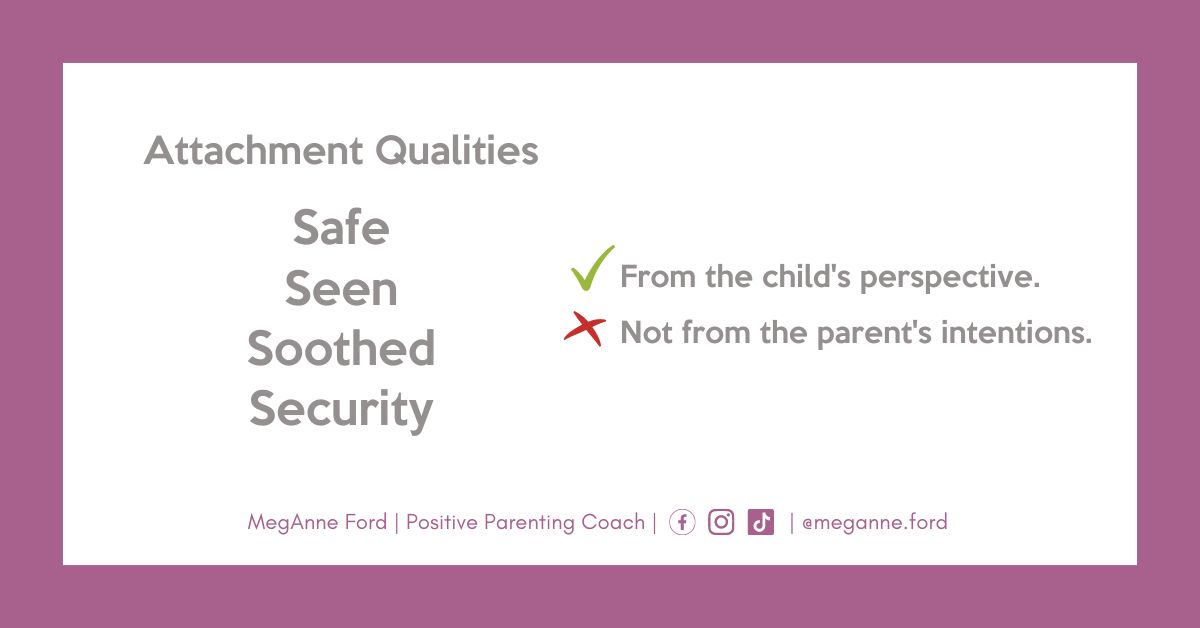
Understanding our past family relationship
The parenting toolbox that we inherited from our parents was missing tools. Stating that our parents were missing tools, is not to criticize or blame them. It's to say they were never aware of the concept of de-centering their own experience. They were unaware of their power within that parent-child relationship or how to share it.
I work in my communities in three phases; awareness, education, and practice. Awareness is often the biggest and hardest step. We resist, our defenses show up, and it often feels uncomfortable. Once we have awareness around something, then we can step into education. We can start reading books, asking questions, taking a class, or working with a coach. As we learn missing tools, we can practice and implement them, taking action to foster a secure family relationship.
BONUS
Disney’s “Far from the Tree” six-minute short visualizes what we have explored. When the original mother and child were on the beach, the mama raccoon was working to keep her child safe using anything she could. Disciplining her child, it was unsafe to come out of the house.
The same process happened when the original child grew up to be the parent herself until she paused and surrendered. She said, “oh wait, I don't want to be in a tree.”
At the end of the short, You see them running and playing together. It is a powerful visual of a parent waking up and saying, “whoa, okay, I want different for us,” not to villainize what was given to me, but to assess what was given to me.
Journal Prompts
Consider when you have wished your child to change first.
What tools did you inherit from your parents?
What tools are you ready and committed to releasing?
Who is on your support team?
A valuable piece of this work is learning that you are powerful as a parent. You hold the power to pass down a new set of tools, and I'm proud of you.
I look forward to hearing from you on the inside 😊







